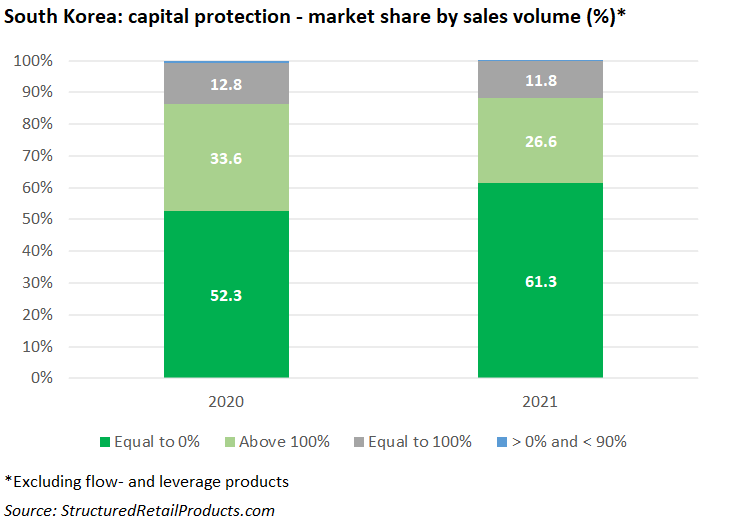Korean investors increasingly opted for riskier products in 2021 as capital-protected structures lost almost 10% in market share.
Capital-at-risk products claimed 61.3% of the South Korean market in 2021, an increase of nine percent year-on-year (YoY).
Some KRW54.2 trillion (US$47.5 billion) was invested in 16,430 structured products that put full capital at risk between 1 January and 31 December 2021, up from KRW48.7 trillion (from 14,733 products) the previous year. Average sales volumes, at KRW3.3 billion, remained level.
Most of these products were autocalls linked to a worst of basket of indices, often including the S&P 500, Eurostoxx 50, and the local Kospi 200. Samsung Securities was the main issuer, collecting KRW7.4 trillion from 2,164 products.
Structures offering a capital return greater than 100% saw their market share decrease to 26.6%, down seven percent YoY.
There were 1,878 such products issued in total, worth a combined KRW23.5 trillion (2021: KRW31.2 trillion from 2,306 products). Average sales volumes, however, at KRW12.5 billion, were much higher than those for capital-at-risk products.
Digital was the main payoff, seen in 1,739 products, while the bulk of the sales volumes came from products linked to a single share – especially those of Samsung Electronics and Korea Electric Power – and interest rates (Certificate of Deposit Rate 91d). Active issuers in this segment were Kiwoom Securities, Korean Investment & Securities, and Meritz.
The latter was responsible for the best-selling product of the year, Meritz ELB 218, which achieved sales of KRW1.3 trillion in December 2021. The one-year bond is linked to the Kospi 200 and returns at least 102.6427% of the nominal invested at maturity.
The third main category, products offering capital protection equal to 100%, also registered a decrease in market share, from 12.8% in 2020 to 11.8% in 2021.
Some 780 products worth KRW10.4 trillion were issued during the year, down from 1,103 products with sales of KRW11.9 trillion in 2020, although average sales volumes increased (KRW13.3 billion per product in 2021 vs KRW10.8 billion in 2020).
Payoffs were a mixture of accrual/range (169 products), bull bear (68), credit-linked notes (43), and shark fin (27). More than 70% of sales came from product tied to the interest rate while Shinhan Bank, which issued 95 products, was the number one provider in this category.
Two hundred and thirty-one products (KRW184 billion) protected between 90 and 100% of the nominal invested (2020: KRW416 from 289 products) while a further 338 products (KRW93 billion) protected up to 90% of the capital (2020: KRW828 billion from 476 products).

